June 2010
Supermarine Seafang Mk 31, Blackburn Roc
![]()
Links
to related pages on this Website: ![]()
![]()
![]()
![]()
![]() This
Month's significant WW2 70th Anniversaries:
This
Month's significant WW2 70th Anniversaries:
4 June - Operation Dynamo, the evacuation of allied troops from Dunkirk is complete. Winston Churchill addresses the House of Commons:
We shall go on to the end, we shall fight in France, we shall fight on the seas and oceans, we shall fight with growing confidence and growing strength in the air, we shall defend our Island, whatever the cost may be, we shall fight on the beaches, we shall fight on the landing grounds, we shall fight in the fields and in the streets, we shall fight in the hills; we shall never surrender, and if, which I do not for a moment believe, this Island or a large part of it were subjugated and starving, then our Empire beyond the seas, armed and guarded by the British Fleet, would carry on the struggle, until, in God's good time, the New World, with all its power and might, steps forth to the rescue and the liberation of the Old .
7 June - HMS GLORIOUS lands on Hurricanes and Gladiators from 263 and 46 Sqn RAF that are being evacuated from Norway. Early next day, proceeding independently of her convoy, she encounters the German Battlecruisers Scharnhorst and Gneisenau and after a short engagement she is sunk, along with escorting destroyers HMS Ardent and Acasta. 1,519 men are killed; only 45 survive.
10 June - Italy declares war on the United Kingdom and France. General Rommel's Panzers reach the French coast.
12 June - 13,000 Allied troops, including the entire British 51st Highland Division, are trapped at St Valery-en-Caux when the French Army collapses, and are forced to surrender en-masse to Rommel. To put this disaster into perspective: there are currently a total of 9,500 British personnel fighting in Afghanistan (2010).
17 June - Marshal Petain's French Vichy Government asks Nazi Germany for an Armistice. Operation Ariel, the evacuation of Allied troops from France begins. In the bloodiest single engagement suffered by British & Commonwealth forces during the entire war, RMS Lancastria, a troopship carrying nearly 6000 men, is sunk by a Ju88 bomber off St Nazaire. There are few survivors.
18 June - Winston Chirchill tells the nation: "The Battle of France is over, the Battle of Britain is about to begin". From London, General De Gaulle broadcasts an appeal to all those French citizens who remain free, to reject the Vichy government and continue the fight under his leadership, alongside the British: "Car la France n’est pas seule ! Elle n’est pas seule ! Elle n’est pas seule !" "As France is not alone!, she is not alone!, she is not alone!". "Whatever happens, the flame of the French resistance must not be extinguished and will not be extinguished". "Vive la France libre dans l’honneur et dans l’indépendance !"
30 June - German forces land in Guernsey, beginning 5 years of Nazi occupation.
Lothians & Borders War Diary
|
|
1 -4 June - Under heavy artillery fire, the 1st Lothians & Borders Yeomanry dig in at Abbeville and await the expected German assault. 4 June - A desperate counter attack through the Lothians' lines, by French armour and the Cameron Highlanders, is unsuccessful and suffers large casualties. This is the last occasion on which the Division will see the RAF in the air. 5 June - 0430 - A massive German assault begins across the entire front, with armour and close air support from Ju87 dive bombers. Despite heavy fighting, the Lothians defensive line is held until 7th June when the Regiment is withdrawn across the river Bresle. 9 June - The Lothian's tanks remain in constant contact with the enemy, providing flanking cover for a wider withdrawal. 10 June - With German forces surrounding them, the 51st begins a fighting retreat to the small coastal port of St Valery. The Lothian's tanks are ordered to hold the Germans "at all costs" to allow the withdrawal to proceed. Although the British troops have plenty of transport, they are ordered to await the horse drawn French troops with whom they are fighting. 11 June - A defensive perimeter is established around St Valery, however French units begin to surrender, some blocking the Highlanders lines of fire as they do so. The Lothians' tanks remain in constant contact, whilst other elements of the 51st Division engage in vicious hand-to-hand fighting with German infantry. Nevertheless, Rommel's Panzers seize the high ground and begin intense bombardment of the beaches, to prevent evacuation by sea . At 2200 hrs, with the French in full retreat, General Fortune orders the Lothians to destroy or immobilise their tanks, ammunition and other equipment and to move into the town for evacuation, or to attempt to escape on their own. 12 June - St Valery is shrouded in thick fog and the evacuation armada cannot reach the beaches. General Rommel enters St Valery and accepts the surrender of the 51st Highland Division from Major General Fortune. Out of the entire 1st Lothians and Borders Yeomanry, only 3 Officers and 17 Other Ranks manage to escape; the remainder are taken into captivity. |
Supermarine Type 382 Seafang Mk.31, Carrier Trials Unit, HMS ILLUSTRIOUS, 1946.
AZ 1/72 Spiteful modified
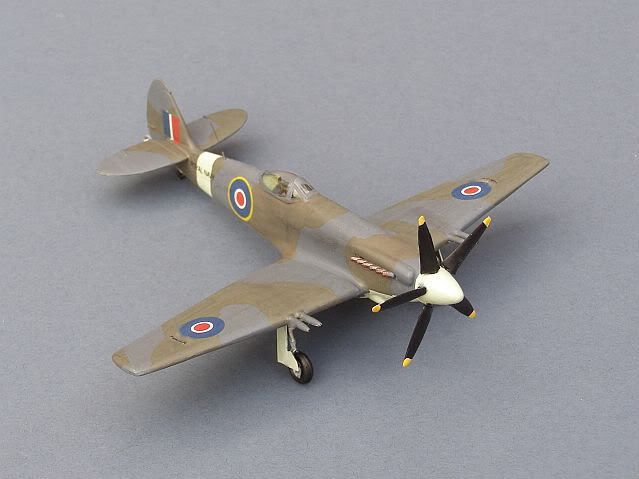
The Seafang and Spiteful were the last gasp of the Spitfire line. By 1943 it was evident that the Spitfire airframe had reached its physical limits, so Supermarine began work on an advanced wing to allow far higher speeds. The laminar flow wing was thinner, with a sharper leading edge and with its thickest part further aft. By allowing the air to flow around the wing with less turbulence, drag would be reduced and the top speed of the aircraft would increase. At the same time, the overall shape and construction of the wing were simplified, overcoming a long lasting production limitation of Mitchell's original Spitfire wing design. A new fuselage was also designed, with a lower nose overcoming the visibility issues that the longer Griffon engine had brought, whilst a larger tail unit restored the longitudinal stability lost with the more powerful engine and the bubble-top after deck.
The Spiteful and Seafang were modestly successful and were certainly very fast, although the new wing showed some undesirable characteristics when approaching a stall. None of these were significant issues for such a radical design and could have been overcome in time, but the end of the war, the emergence of jet technology, plus the success of the rival Hawker Fury/Sea Fury and Seafire 45/47 designs, meant that further development of the aircraft was halted after only 19 had been built.
Nevertheless, the advanced laminar flow Spiteful wing did eventually see active service, evolving into the awkward looking Supermarine Attacker, the Royal Navy's first operational jet fighter.
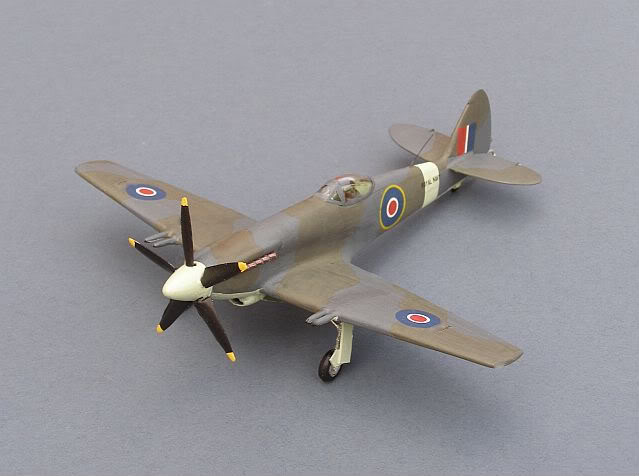
Through a strange twist of fate, the vagaries of the M25 and the wisdom of my Tom Tom, early last month I found myself driving along the A25 toward Dorking. Aha, thinks I, there used to be a good model shop in Dorking. Well, I was last there over 20 years ago, but I am delighted to report that it still exists and is every bit as good as I remember.
I had hoped to pick up AZ's recent Seafang Mk32 "What-if" kit, but the shop owner told me that they had rapidly sold out, so I consoled myself with the very similar Supermarine Spiteful kit and resolved to get the putty and scribing tools out. Whilst there are significant differences between the Spiteful and the Mk32 Seafang, not least the contrarotating propeller and tail hook, the Mk31 Seafang was essentially a Spiteful with a hook, and since this is a "what-if", who can say otherwise?
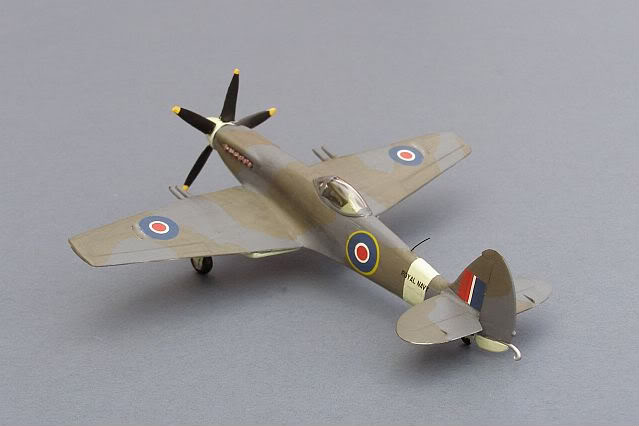
The kit is well moulded with softly engraved detail on a single sprue, and the clear canopy lying loose in the sealed poly bag. Although it is not a large box, for the price charged there is relatively little actually in it. However, what you do get is very nice. As might be expected of a short-run kit, there are no locating pins, a little flash around the wings and the general level of fit is suspect in some areas. I found the cockpit to be particularly vague, but in truth you can hardly see it once complete, so I'm not sure why I put so much effort into it!
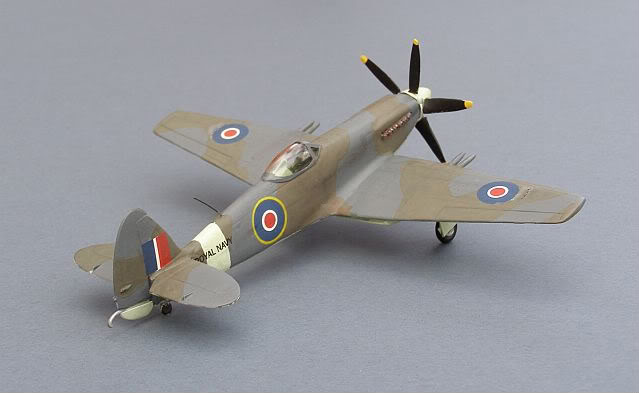
The only change I have made is the addition of the tail hook, made from stretched sprue. Decals/transfers came from the spares box and represent one of only 9 Seafangs that were actually flown.
Link
to more Seafires on my Seafires Pages
Blackburn Roc L3154, 805/806 Sqn Fleet Air Arm, RNAS Donibristle/Eastleigh/RAF Detling, 1940.
Pavla 1/72
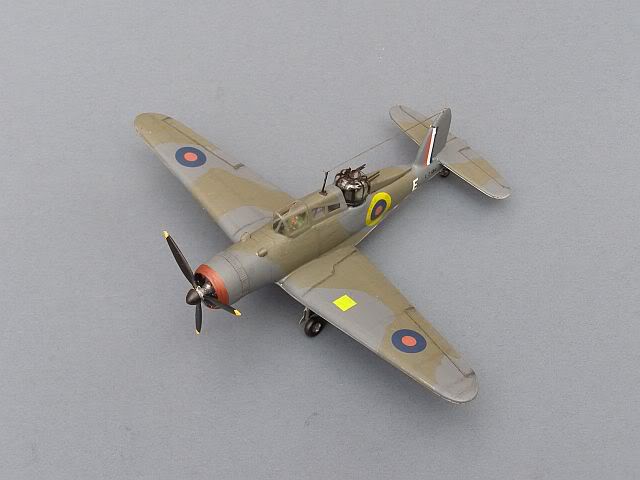
After the decision to withdraw RAF Fighter aircraft from France and retain them for home defence, a hotch-potch of Royal Navy aircraft were committed to assist by operating over the beaches of Dunkirk and Calais in May and June 1940. For the most part, this meant the Skua and Roc, already discredited by their poor performance in Norway and barely able to put up a credible fight.
Like its contemporary, the Bolton Paul Defiant, the B-25 Blackburn Roc followed the unsuccessful concept of the turret-armed fighter. Developed from the multi-role Skua, Rocs saw very little front-line service, and almost all of that was based ashore, before it became painfully obvious that they were no match for the Luftwaffe and they were withdrawn to training and support roles.
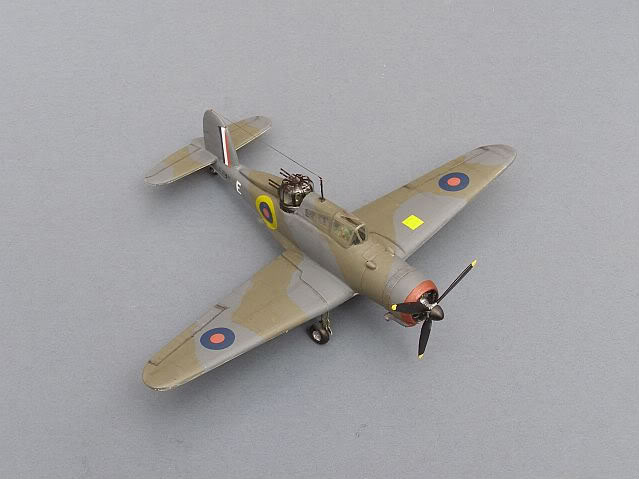
Nevertheless, the Roc did participate in some of the crucial events of the early war, including the defence of the Home Fleet's base at Scapa Flow, the Norwegian Campaign (when several Rocs saw their only sea-based service onboard HMS ARK ROYAL), Dunkirk, Cherbourg & St Malo evacuations in June 1940, plus it played a small part in the Battle of Britain (in defence of the Dockyard at Portsmouth). RAF-manned ROCs were even used as static ground based anti-aircraft mounts at RAF Gosport.
Only one confirmed victory is credited to the Roc, a Ju88 shot down over Ostende during the Dunkirk evacuations, by an 806 Sqn Roc flown by Midshipman A G Day RN.
For more information on the Roc, please have a look at this excellent website: http://freespace.virgin.net/john.dell/blackburn_roc.htm
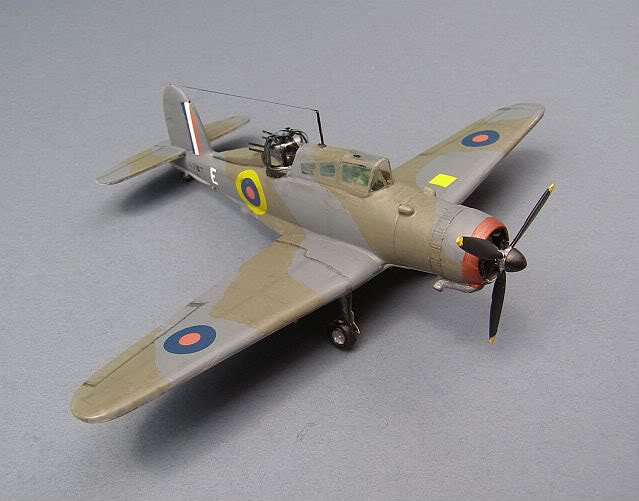
Czech company Pavla produced this short-run kit of the Roc in the late 1990s. So far as I know it was the first ever injection moulded Roc and it is very typical of that period; lots of potential, but certainly not one for the beginner. This is one of the kits that built up the superb reputation of Czech industry and whilst it may be a little rough around the edges (and it wasn't cheap), it definitely lights my fire!
The kit provides markings for aircraft from 806 Sqn, RNAS Hatston, Orkney Islands 1940, 759 Sqn, Eastleigh Airport, 1939, and 775 Sqn Dekhelia, Egypt, 1942.
I couldn't resist the "different" markings for 759 Sqn, but I wanted to do something both Battle of France and Battle of Britain 1940, and with some link to my own life, so I have modified mine to reflect one of the aircraft used by 805 and 806 Sqn at RNAS Donibristle, Scotland, (near where I grew up). 806 Sqn was moved south to Eastleigh, then to RAF Detling to operate over France and Belgium in support of the BEF during June 1940.
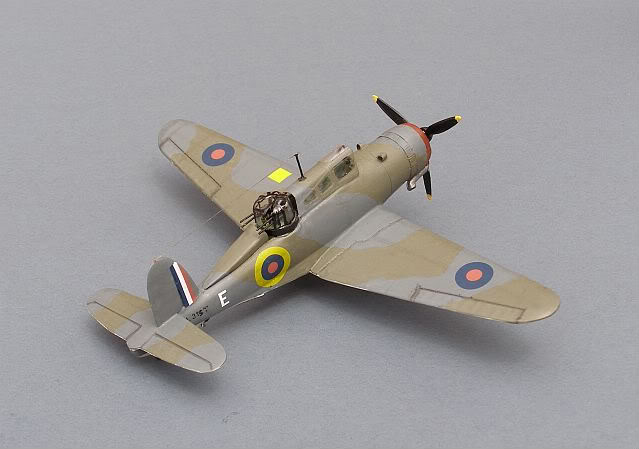
806 Sqn quickly replaced their Skuas and Rocs with Fulmars, and handed their aircraft over to 759 Training Sqn at Eastleigh and the short-lived 805 Sqn at Donisbristle, who were training to become a Roc Floatplane squadron for operations in Norway, before events overcame them (805 formed at the beginning of one week, then disbanded at the end of the next!).
The kit comes on a single sprue, with brass photo-etch and vac-form canopies (2-of). Detail is delicately engraved, but my kit had a fair amount of flash that needed to be removed with equal delicacy. The level of internal detail attempted is very impressive, but defeated slightly by moulding limitations. Decals are by Propagteam, and are excellent, if very slightly translucent.
I think that it would be entirely fair to describe this kit as "challenging". Parts fit is not at all good (although contained with Tippex as filler), and there are many moulding/ejector stubs that need to be carefully removed to allow parts to join. Detail parts are provided in photoetch, and the instructions also call for a lot of scratch building.
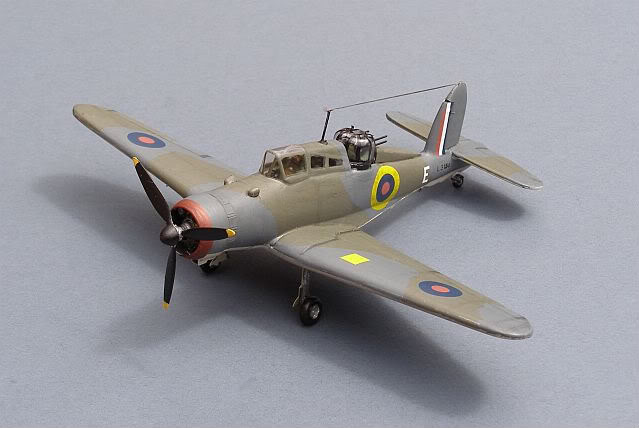
I found the joint of the upper and lower cowling particuarly difficult - the plastic is very thin, but with rough edges; much Tippex was used to fill the gaps. Same with the brass undercarriage bay profiles - although there are indentations for these to sit in, tidying up the edges still requires some effort. The undercarriage assembly is very fragile and the supporting arms all broke as I removed them from the sprue.
The single arm stinger hook provided in the kit is wrong - it should be an A-frame, so a replacement was scratch build from copper wire. I also wimped out on the gun barrels for the time being, until I think of a way to do them adequately.
Markings and painting gave me some difficulty; various references suggest that the 805 and 759 Sqn aircraft, with their low demarkation topside camouflage, may have been in the RAF Brown/Green Temperate Land Scheme, rather than the Extra Dark Sea Grey/Dark Slate Grey Temperate Sea 1 Scheme. If this is the case, then both Pavla and Special Hobby, plus various aviation artists, have got it wrong. However, one of the known issues 806 faced over France was the fact that their grey/green camouflage regularly resulted in their being misidentified as Germans, since AA gunners were used to RAF aircraft and their brown/green paint, so it could equally be right!
In the end, I opted to follow the kit instructions, but I do believe there is still reasonable doubt.
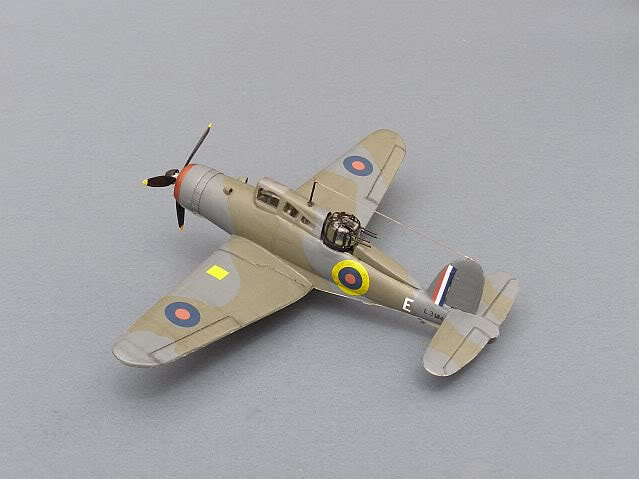
In summary; a difficult kit to build, expensive with some surprisingly crude moulding, but nice engraved detail, plus some areas of questionable accuracy.
But hey....... its a Roc!
Link to my WW2 RN Aircraft pages
Links
to related pages on this Website: ![]()
![]()
![]()
![]()
www.gengriz.co.uk